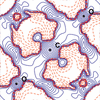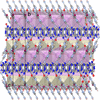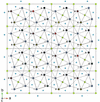issue contents
October 2021 issue

Cover illustration: The inorganic sub-network of the uncompensated antiferromagnet Mn2(OH)2(bpdc), projection along a (see Sibillie et al., pp. 801–807).
opinions
Current state-of-the-art substructure searching in the Cambridge Structural Database is discussed and proposals are made for substructure searching that would encompass both topological searches and searches for molecular fragments that could be used to enable easier searching for complex molecules.
quantum crystallography
This article retraces different methods that have been explored to account for the atomic thermal motion in the reconstruction of N-representable one-electron reduced density matrices from experimental X-ray structure factors and directional Compton profiles.
X-ray restrained extremely localized molecular orbitals (XR-ELMOs) were used in QM/ELMO calculations of excited states to describe the environment of a chromophore. It is demonstrated that the XR-ELMOs can be profitably used for this purpose, also confirming the capability of the X-ray restrained wavefunction approach in capturing environmental effects on the electron density.
This article describes the joint refinement program MOLLYNX dedicated to spin-resolved electron density distribution. Multipole and atomic orbital models are described and applications for organic and inorganic magnetic materials are discussed.
The influence of data manipulation on X-ray wavefunction refinement is analysed. While the Hirshfeld atom refinement always reaches the same results, X-ray constrained wavefunction fitting is extremely sensitive to crystallographic data manipulation as a consequence of the variability of the experimental uncertainties for different resolution intervals.
research papers
Download citation


Download citation


The chemical bonding and anharmonicity of atomic vibrations in stoichiometric single crystals of orthorhombic ferroelectric KNbO3 have been studied by the precise X-ray diffraction method. The features of the electron density in the cation and anion substructures, and their roles in the formation of spontaneous polarization are established.
CCDC reference: 2094437
A symmetry-guided approach for designing and tailoring magnetoelectric and multiferroic M-, W- and Z-type hexaferrites is proposed.
A unified approach is developed to describe the crystal structure of orthorhombic martensite (α′′) independent of chemical composition. It emerges that a large fraction of structural configurations along the b.c.c.–Cmcm–h.c.p. transformation path is not observed in quenched Ti alloys.
Download citation


Download citation


Four chloridobismuthates(III) showing different anionic substructures, two with N,N-dimethylethane-1,2-diammonium and the other two with N,N,N′,N′-tetramethylguanidinium organic cations, were studied with respect to the formation of specific inorganic substructures and, in particular, the factors responsible for their distortions from ideal octahedral geometry. The investigations of the polyhedral distortions were supported by an analysis of data retrieved from the Cambridge Structural Database.
Download citation


Download citation


Open  access
access
 access
accessThe crystal structure of γ-alumina was revealed by electron crystallography and its transformation mechanism from boehmite is proposed.
CCDC reference: 2101470
Download citation


Download citation


Single-crystal neutron and X-ray diffraction data for the orthorhombic and monoclinic polymorphs of the amino acid L-histidine have been collected at 5, 105 and 295 K. The neutron structural models are compared with those refined with the new Hirshfeld atom refinement method implemented in NoSpherA2.
Download citation


Download citation


M2(OH)2(bpdc) (bpdc = biphenyl dicarboxylate, C14H8O4) is an uncompensated antiferromagnet crystallizing in space group P1, whereas the isoreticular Mn2(OH)2(bdc) (bdc = benzene dicarboxylate, C8H4O4) crystallizing in C2/m is a compensated antiferromagnet.
CCDC reference: 2101204
Download citation


Download citation


A new guanine salt hydrate, K+·C5H4N5O−·H2O, was characterized by single-crystal X-ray diffraction in the temperature range 100 K–300 K.
A novel strategy is provided for the preparation of polyethylene oxide (PEO) single crystals, combining liquid casting technology and the self-seeding method. The resulting PEO single crystals exhibit an ordered single-crystal structure.
Open  access
access
 access
accessMagnetic structures in R2Ni1.78In (R = Ho, Er and Tm) are determined from powder neutron diffraction data with the support of symmetry analysis. The results of DC magnetometric measurements for Tm2Ni1.78In are also reported.
A theoretical investigation of structural and electronic properties of TiO1–xSx (x = 0, 0.25, 0.50, 0.75 and 1) solid solutions is presented. Calculations are performed at the ab initio level using density functional theory and the Crystal17 software.
Download citation


Download citation


Three rare structurally different homometal multinuclear CuII bis(salamo)-based complexes have been successfully synthesized and structurally characterized. Due to the existence of different solvent molecules and counter anions, the structures and interactions of the three complexes are influenced.
addenda and errata
Free 

In the paper by König & Smith [Acta Cryst. (2019), B75, 788–802], several equations had minor errors in their coefficients defining characteristic lengths and area of zinc-blende nanowire cross sections, thereby deviating from the exact analytical solution by 1.4 ± 0.8 %.


 journal menu
journal menu









































